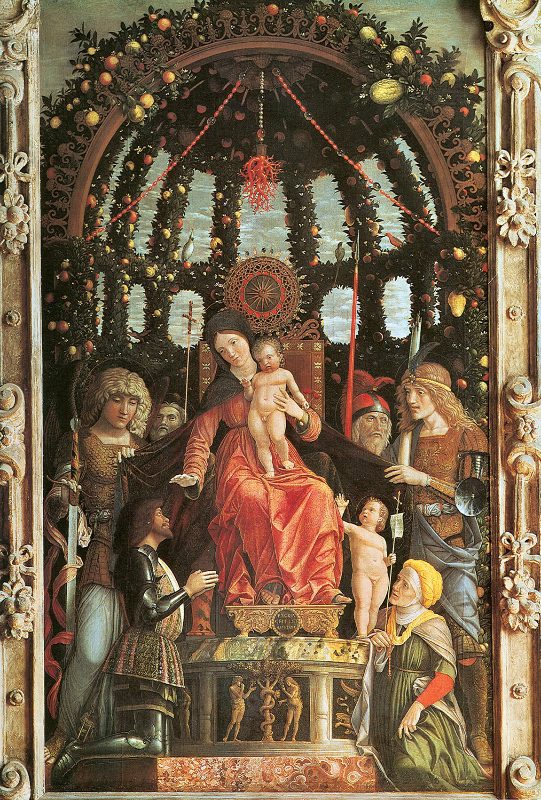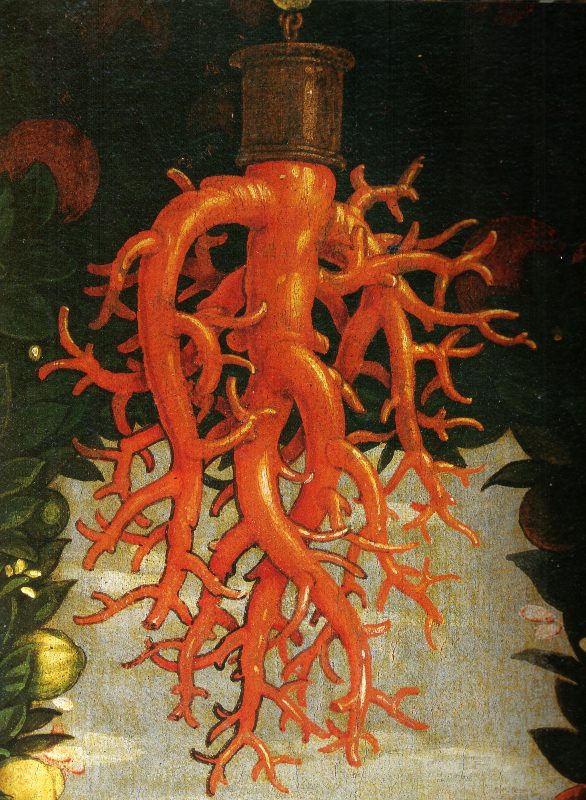
Andrea Mantegna

Andrea Mantegna
At first sight this coral in Andrea Mantegna’s painting looks like an abdominal aorta, the Superior Mesenteric Artery arising at its upper end, other branches from lower down. Corals are the products of minute marine sack-like organisms that live in compact colonies or reefs, secrete calcium carbonate to form a hard skeleton, and may grow by branching out like a tree. Long worn as necklaces and other jewelry, corals have also been used medicinally to protect from depression, treat hiccups, colic, and heartburn, even diseases of the kidneys, bladder, and parathyroid glands. They were given to pregnant women for their supposed amuletic properties and to nursing or teething babies to pacify them and protect them against evil. Because of its deep red color coral was also seen as a symbol of blood, of life and death, and of the blood of Christ foretelling his crucifixion.
In Mantegna’s painting the coral hangs from the high ceiling well above the Madonna. Surrounded by four saints (St. Michael, Longinus, Andrew, and George), she extends her hand to confer a blessing on the kneeling Francesco II Gonzaga who had led the troops against the French army of Charles VIII. This king had assembled the largest army seen in Europe since antiquity, augmented by Swiss mercenaries and equipped with mobile field artillery, and had invaded Italy to assert his claims to the vacant of throne of Naples. In what has been termed a military promenade, Milan, Florence, and papal Rome had no option but to grant him safe passage. However, on his return journey Charles was confronted by a Holy League consisting of Milan, Venice, Pope Alexander VI, and the Holy Roman Empire. At the indecisive battle of Fornovo (July 1495) both sides claimed victory, but Charles was forced to retreat to France and lost all he had plundered during his four years in Italy. Two and a half years later he hit his head on a wooden beam in his castle and died, presumably from intracranial bleeding.
On his return to Mantua Francesco, Gonzaga celebrated his success by erecting the chapel of Santa Maria Madonna della Vittoria and commissioning the famous artist Andrea Mantegna to paint a devotional painting for the altar. To pay for this art he extracted money from Daniele da Norsa, a Jewish banker whose new house had been destroyed by the anti-Semitic populace because he had replaced the image of the Virgin Mary with his own coat of arms. The chapel was built on the site of the ruined house, and the painting was later looted by Napoleon when his troops occupied Mantua. Taken to the Louvre, it was never returned, on pretext that it was too large to be moved.

Leave a Reply